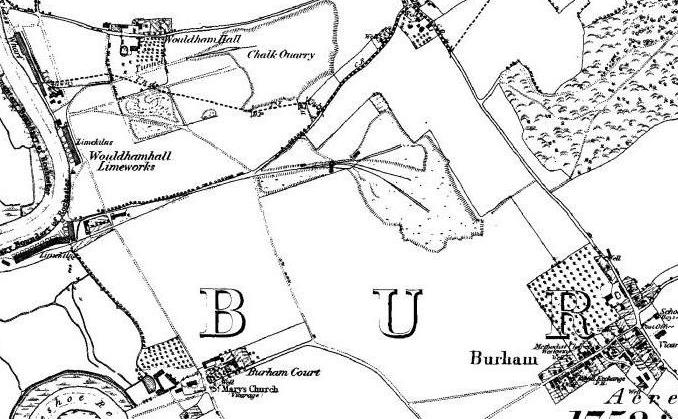A Mystery Lime Works Token From Burham
The obverse and reverse sides of the Burham Lime Works token (Copper, 33 mm diameter).
Can anyone provide any information relating to the above token, the Lime Works to which it refers and/or the "S. BRICE" mentioned in its obverse legend?
I have very little information concerning Burham Lime Works which was obviously located in or around the village of Burham which is located in the Medway Valley in Kent.
During
the nineteenth and early twentieth centuries a whole series of cement works
grew up along the banks of the Medway from Frindsbury to Burham, each with its
pits, industrial railways, works, wharfs and barges. The earliest of the
group, at North Halling, began in 1799. By 1830 Burham had become one of the
local centres of cement production (for which lime is an essential
constituent) after the discovery of the manufacturing technique for Portland
Cement (so called because of its resemblance to Portland Stone). By 1841 the
village's population had grown to 380 and increased to a maximum of 1,725 in
1901. Today its population is only 1,300.
At Wouldham Hall on the north-west side of Burham village there exists surface remains of an extensive Lime Works and chalk quarry. These are the only such features I can fined mapped in the immediate vicinity of the village and is most likely the lime works referred to by the above token.

Burham Village & Wouldham Hall Lime Works (circa 1869).
There is mention of a Burham Brick, Lime and Cement Company Limited in Her Majesty's Inspector of Mines Report (Quarries Section) for 1895. This again may be connected with Wouldham Hall which interestingly is located just across the River Medway from the Halling Lime Works Works. As yet I can find no record of an "S. Brice" associated with either of the above former enterprises.
I am not sure what the above token could have been used for. It may have been a time or pay check in which case the number stamped on its reverse would have been a worker's identification number. Alternatively it is possible that it may have been a carriers token, i.e. a receipt for the carriage of "1 load" of lime from the works to a local market or customer. Similar carriers tokens were a feature of the coal and lime industries in West Cumberland up until at least the mid nineteenth century.
Stylistically the token is similar to many Refreshment or Public House tokens of the 1870s-80s although it is of a slightly larger in diameter than most others. It is not unfeasible that it could be such a token although I am unaware of a "Lime Works" pub in Burham. If it is a refreshments token the stamped number on its reverse could be interpreted as a denomination of "1d" whereas the name of "S. Brice" on the obverse could relate to that of an Inn landlord or licensed seller of wines and spirits in the local neighbourhood. From the mid nineteenth century Burham village possessed at least four public Houses. These were "The Royal Exchange" established in 1812, "The The Windmill" established in 1874, "The First And Last" established in c.1880s and the much older Fleur De Lys which dates back to the sixteenth century. At least one of these pubs (The Windmill) was established as a direct response to the village's rapid growth in population due to the expansion of the local lime and cement trade. If this is a refreshments token it may have been issued by the local Lime Works to their workers in part payment for their labours or lieu of payment for overtime etc. Although the token's style dates it to post 1832 (i.e. when the Truck Laws stopped payment in goods or tokens) it is known from other branches of the UK's minerals industries (e.g. Llanhilleth Colliery, in South Wales) that supplementary payment to regular wages and/or for overtime working continued in the form of beer tokens into the twentieth century.
We have checked for a "Lime Works" public house plus the potential landlord
"S.Brice" in our data base of British Public Houses. The only entry we have
that might be relevant is for a "Stephen Brice" at the Five Bells, Eynsford
from 1860 to1865. Eynsford is approximately 10 miles from Burham in Kent. We
have no entries for BRICE in Burham at present.